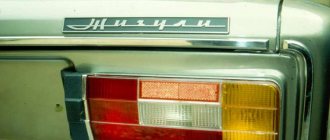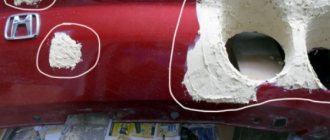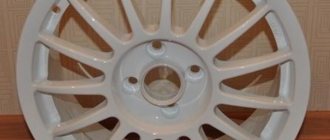Gasoline cans can be useful for motorists on long trips through sparsely populated areas where there are few gas stations, or when you need to wait until you get to a gas station of a certain brand and avoid refueling at a “no-name” gas station.
Also, canisters, as assistants, are indispensable for owners of motorcycles and gasoline-powered equipment: ATVs, chainsaws, lawn mowers, snow blowers and others. Let's find out what types of canisters there are, whether all canisters are filled at gas stations, and how to choose the best canister. When choosing a canister, you should pay attention to the following parameters:
- compliance with standards for the transportation and storage of flammable materials;
- volume;
- design;
- form;
- material;
- corrosion resistance;
- closing reliability;
- neck diameter;
- internal pressure that the canister can withstand;
- resistance to deformation;
- Ease of use.
Volume
Gasoline cans are divided into several groups by volume:
- small 5 liters;
- average 10, 20 liters;
- large 30, 40, 50 liters;
- fuel canister tank 100 liters;
- industrial 250-1000 liters.
There are canisters of other sizes, but they are not so common and are not in great demand. For personal use for storing and transporting gasoline, the most popular canisters are 5, 10, 20 liters.
The declared volume of the canister may not correspond to reality. According to safety rules, gasoline can be poured into a canister up to the bottom of the neck. If the canister is 20 liters, then this volume should fit exactly up to this level.
Most canisters have an air pocket at the top, which serves to compensate for the increase in fuel volume when heated and to provide buoyancy. It is forbidden to fill a canister with gasoline up to the top of the neck and completely by tilting the canister with the neck up and using the air pocket.
Small and medium canisters of 5-20 liters are convenient for transportation in the trunk. Large cans are mainly used for storing fuel in a garage or country house.
What's the result?
Shell The clear winner in our test. It will easily survive a fall in winter and heating in the summer, but its cost is one and a half to three times higher than the cost of competitors. In addition, for that kind of money you want to get a more carefully made product - before use you will have to clean and cut off the bur from almost the entire canister. However, whatever one may say, this is the only sample that passed the entire test cycle.
Airline The canister has a good combination of price and quality. The only downside is that it takes a long time to pour out the liquid due to the single-channel spout. If a full canister falls, it may receive hidden damage, which will only open with strong heat and increased pressure.
Rexxon The undoubted advantage of this canister is the well-thought-out two-channel pipe for draining the liquid. This canister also turned out to be the most voracious: under the cap you can pour almost a third (!) more than the declared nominal value. But due to flash on the end surface of the neck, along which the plug is sealed, leakage is possible. So it will require some work, and if the canister is dropped on a corner, it may begin to leak a little.
“Mammoth” The heaviest canister that is afraid of falling, especially in the cold - the lid will break. The stated figures do not correspond to reality. Taking into account the quality of the canister, its cost is clearly too high.
“Prometheus” The cheapest canister with the largest hole under the handle, which is convenient. But alas, it is afraid of both frost and falls: it splits along the seam, flooding everything around.
Design
The design of canisters is:
- vertical
- the most common, they are convenient to carry, but during transportation they require additional fastening to prevent them from tipping over. The side walls should have stamped stiffening ribs that increase the strength of the container. - Horizontal
- with a wide base, such canisters are longer than they are high. Due to the horizontal distribution of the center of gravity, the risk of the canister tipping over during transportation is eliminated. The neck is located at the top; the canisters are often supplemented with a tube that simplifies the process of pouring fuel into the tank. - Combined
or two-section canisters consist of two containers. Fuel is poured into one, adhesive oil for chainsaw chains or motor oil into the other. These canisters are in demand among owners of garden equipment and gasoline-powered tools, which require adding motor oil to gasoline to refill.
According to their design, canisters are also divided into:
- solid
- the most common canisters; - folding
- these are polymer heat-resistant elastic canisters, popular among owners of ATVs, jet skis, motor boats, yachts, and snowmobiles; - backpack
- designed in the form of a backpack that can be carried on the back. Used by the military and tourists.
Each canister consists of the following elements:
- tank
- neck
- lid
- pen
Neck
The neck can be located in the center of the upper wall of the canister or shifted to the edge. The offset neck is more convenient and safer, as it provides an air cushion above the surface of the fuel and a smooth flow of fuel when pouring, without gurgling or pulsation.
A siphon tube must be built into the neck, which ensures the flow of air into the canister when pouring fuel. The neck seal must be of a design that does not prevent complete emptying of the canister. If it is made like a sippy cup, then you won’t be able to pour out all the gasoline completely.
Neck diameter:
- with a wide neck 50-90 mm;
- with a narrow neck 29-45 mm.
The diameter of the neck affects the speed of fuel transfer: through a narrower neck, liquid pours out more slowly.
Lid
Canisters have two types of lids:
- Threaded plug
— screw connection with thread and a cover made of stainless steel or plastic with a gasket made of oil-gasoline-resistant rubber. The threaded cap must be screwed on firmly to prevent fuel leakage. Over time, it corrodes and becomes difficult to twist. To improve rotation, you can lubricate it with oil. - Retainer
- clamping mechanism. The clamping mechanism is considered more reliable than a threaded cap. But in extreme heat, under the pressure of the vapors generated in the canister, the internal pressure can be so high that the clamp can break.
Sealing gasket
A gasket must be present with any lid closing mechanism. It has a very important function - it provides sealing inside the canister, thereby preventing evaporation and leakage of fuel.
There are two types of gaskets:
- gaskets made of oil-gasoline-resistant rubber
(MBR). They are used in fuel environments where the base is oil or gasoline. This rubber can withstand temperature changes from -30ºС to +80ºС. When exposed to fuel mixtures, MBS rubber retains its shape, structure and elasticity. Such gaskets eliminate gaps between surfaces, withstand shock loads and prevent the leakage of gasoline, diesel fuel, kerosene and oil. - Gaskets made of ethylene propylene rubber
(EPDM). They are mainly used when working with solvents, acids, alkalis, and alcohols. In the automotive industry, they are used to make door, hood, trunk seals, pipes, tubes, hoses, and gaskets.
A standard factory gasket must be included with the new canister. Over time, it can become unusable and lose its original properties. Then you will need to buy a new one, choosing the right size.
Pen
The handle is located at the top of the canister; it should be comfortable for carrying the canister and have a comfortable grip when pouring fuel. Sometimes metal canisters have three identical handles next to each other.
This design has three advantages:
- allows one person to carry a canister, or two people to carry one canister;
- one person can carry two empty canisters in one hand;
- It is convenient to transfer such canisters to each other along a chain.
Such containers are used mainly by the military.
Rules for storing gasoline
For proper fuel storage, the following conditions must be ensured:
- the container must be closed hermetically, preventing gasoline from evaporating;
- Direct exposure of the canister to sunlight should be avoided;
- The lower the storage temperature, the longer the fuel retains its combustible qualities.
For central Russia, under normal conditions, the shelf life of gasoline does not exceed 12 months in a canister and 6 months in a car tank. In the southern regions it decreases by a factor of 2, and in the northern latitudes, on the contrary, it increases by a factor of 2.
To use expired fuel for its intended purpose, you must first restore its properties. This is done as follows: you need to add fresh gasoline of the same brand to old gasoline in a ratio of 1:2 or 1:3, i.e. For 1 liter of old, add 2-3 liters of fresh gasoline.
Canister material
Canisters for gasoline, diesel fuel and kerosene are made from the following materials:
- steel
- galvanized steel
- stainless steel
- aluminum
- plastic (polypropylene, elastic polyethylene)
Let's take a closer look at the canister made from each material.
Steel cans
Steel is a lightweight material that is resistant to chemical influences (in particular gasoline), but is highly susceptible to corrosion. Steel canisters are most often produced in a classic rectangular shape. They are produced by stamping from sheet steel with a thickness of 0.6-0.8 mm, followed by welding of the side seams.
Stiffening ribs are additionally stamped on the side walls. The outside is powder coated to protect against rust and baked in a thermal oven at 300°C. This ensures the strength and durability of the coating. Also, instead of paint, they can be galvanized inside and out, for example, galvanized cans.
The locking device is a metal plug with a thread or a clamping-lever mechanism, which are sealed with an oil-gasoline-resistant gasket. They can be equipped with a flexible plastic drain tube and an overpressure valve.
Different manufacturers, in order to reduce the cost of canisters, save at various stages of production, so when choosing the cheapest version of the container, you should not expect good quality: the paint may begin to fall off, the gasket may be made of ordinary rubber and gasoline will corrode it, the cap may leak, the canister may begin to rust from the inside with poor treatment of internal surfaces, etc.
Advantages of a steel canister:
- a light weight,
- resistance to gasoline,
- high mechanical strength.
Disadvantages of a steel canister:
- susceptible to corrosion processes;
- corrosion products inside the canister enter the fuel;
- If the steel is thin, the canister may become deformed due to mechanical shocks and temperature.
Stainless steel canisters
Stainless steel is an alloy steel (steel with additives) that is resistant to corrosion and chemical attack. The canisters are made of stainless steel sheet with a thickness of 0.6-0.8 mm. Withstands internal burst pressure of 0.2 MPa.
Most have a classic rectangular frame with a vertical or horizontal design. Available in various volumes: 2, 3, 5, 10, 20, 25 l. Stainless steel canisters are the most durable, resistant to external chemical and mechanical influences, and do not require additional surface treatment.
Advantages of stainless steel canisters:
- unlimited shelf life,
- corrosion resistance,
- resistance to mechanical shocks,
- high temperature resistance,
- chemical resistance,
- large selection of models by volume,
- beautiful appearance that does not deteriorate over time.
Disadvantages of stainless steel canisters:
- very high price
- heavy weight of the canister.
Aluminum canisters
Aluminum is a lightweight, soft, medium-strength material that does not corrode. Most have a classic rectangular shape with a vertical design. There are volumes of 5, 10, 20 liters. The maximum internal pressure at which the housing is sealed is 0.2 MPa.
They can be manufactured with or without an air bag. The former are preferable, since when heated, the liquid expands and enters an air bag, which is connected to the neck using a siphon tube.
The welding handle must withstand double the weight of a canister filled with water.
Advantages of an aluminum canister:
- a light weight,
- resistant to chemical attack,
- high anti-corrosion resistance (do not rust),
- durable,
- allow you to store gasoline for a long time,
- cheaper than steel
- possibility of recycling.
Disadvantages of an aluminum canister:
- soft, easily deformed under mechanical stress;
- difficult to clean;
- are available in one form.
Made from sheet aluminum, the inner surface of the canister is etched to prevent the formation of aluminum oxide. This protects gasoline from contamination by fine oxides, but over time this protection gradually decreases.
Plastic cans
Plastic canisters are made from petrol-resistant polypropylene and elastic high-density polyethylene (HDPE) using the extrusion blowing method with the addition of dyes, antistatic and ultraviolet additives. Antistatic additives prevent the accumulation of static electricity, so such canisters do not “spark” when refilled.
Since food (water, milk, oil) and technical (motor oil, solvents, coolants, fuel, etc.) liquids can be stored in plastic canisters, there are an abundance of plastic canisters in stores, which makes it difficult to choose a suitable container for gasoline. You can rely on the seller’s advice only if he is well versed in this issue.
Is it possible to refuel at a gas station in a plastic canister?
A plastic gasoline canister must have a number of characteristics and meet mandatory requirements. Otherwise, you may encounter a refusal to fill a plastic canister at a gas station. Not all plastic can be filled with fuel: an unsuitable canister can burst, become deformed, catch fire, break, dissolve, and gasoline can seep through the walls of the container.
That is why gas stations most often do not fill them in plastic cans. Previously, the rules for the technical operation of gas stations in the Russian Federation stated: “It is prohibited to dispense petroleum products in plastic and glass containers.” Both plastic and glass accumulate static electricity, which can cause a spark that could cause the contents of the canister to explode.
The gas station operator cannot check compliance with all the requirements; it is easier to refuse to refill plastic containers or offer to buy the canister that is sold at their gas station and meets all standards. As an option, take with you a certificate of conformity for a plastic canister.
Now there is a new GOST R 58404–2019, which came into force on June 1, 2022 and is called “Gas Stations and Gas Complexes. Rules of technical operation".
Let's go to paragraph 8.2.5: “Dispensing petroleum products in glass containers is not allowed. Dispensing petroleum products into containers made of polymer materials is permitted only if it bears the manufacturer’s marking indicating the possibility of its use for storing petroleum products. The volume of the container must be greater than the minimum dose delivered by the fuel dispenser, established by its manufacturer in the operational and technical documentation.”
When choosing a plastic canister for gasoline, you need to pay attention to the following points:
- plastic appearance . The plastic should be smooth to the touch. If it is rough and coarse-grained, this indicates that it is intended for oil or other vehicle fluids. The plastic should be very hard and smooth and not bend when pressed. It is better to choose a canister of bright colors. Canisters of dark colors with stains indicate secondary raw materials in their manufacture.
- Marking on the canister must comply with the requirements of the international agreement ADR (“Road Transport of Dangerous Goods”), which regulates the rules for the transportation of hazardous flammable substances. There must be a certificate of compliance with the requirements for the transportation of dangerous goods. The inscription “for technical liquids” is not suitable.
- Gasoline cans must be marked “UN Class Certificate” . It determines the permeability of the walls of the container. Gasoline is highly fluid and penetrating and can ooze through small cracks and pores in plastic. The fluidity and penetrating power of gasoline is higher than that of water, which is why gasoline should not be poured into unsuitable containers.
UN standards determine the permissible permeability of canister walls: - for 5-liter canisters - 0.0016 g/lh; — for 10-liter canisters — 0.001 g/lh; — for 20-liter canisters — 0.0009 g/lh.
- There should be stiffening ribs , which increase the resistance of the container with increasing internal pressure and mechanical loads. If you close the canister with a stopper and stand on it, it should practically not be pressed through and retain its shape. In the same way, you can check the tightness of the stopper and seams of a filled canister.
- Weight . A canister for gasoline weighs much more than a canister of the same volume for water, oil or technical fluids. More weight indicates high-quality plastic and thick walls. A 5-liter canister should weigh 500 g, a 10-liter canister should weigh 700 g, and a 20-liter canister should weigh at least 1 kg.
- The canisters are equipped with special funnels or threaded filler spouts . The advantages of the filling spout are that it is more compact compared to a funnel. The spout should screw tightly onto the neck. If it is put on loosely, then most likely, when pouring, gasoline will flow through this connection, and can get on your hands and the paintwork of the car or motorcycle. Gasoline is a strong solvent and is harmful to paint.
Advantages of plastic canisters:
- lungs,
- silent,
- chemically resistant
- easy to clean,
- low price.
Disadvantages of plastic canisters:
- deformation when exposed to high temperatures (for example, prolonged exposure to the sun);
- less durable than metal ones, may crack after a strong impact;
- over time, the canister may lose its antistatic properties;
- possible refusal of service at the gas station.
Modern: plastic
The material is good on all sides. But! It is prohibited to pour fuel into plastic cans in Russia. And if you run into a lawyer, you will be able to prove that the container is intended specifically for gasoline. So when purchasing, do not peel off the sticker where it says that the canister is certified for gasoline. Or pump out the reserve from the tank (if such a procedure is possible).
The only thing I can complain about is that the plastic swells in the heat. Of course, by definition it cannot explode, but it does not look very aesthetically pleasing. In addition, increased pressure on the lid from the inside can depressurize it over time.
Based on this information, decide which gasoline canister is best for you personally. Most travelers usually opt for aluminum ones - unless they are lucky enough to inherit or buy stainless steel gasoline containers on occasion.
Steel cans
Horizontal canister 20 liters AUTOPROFI KAN-500 20L
Canister AUTOPROFI KAN-500 20L is a canister made of galvanized steel from the Russian brand AUTOPROFI, production is located at 30 enterprises in Russia, Taiwan and China. The canister is designed for transportation and storage of various fuels and lubricants, including gasoline.
It has a horizontal shape without sharp corners, is very stable during transportation, there is no risk of tipping over, and therefore does not require additional fasteners in the trunk. Volume 20 liters, three handles for easy carrying by two people. Empty canister weight 3.3 kg. The canister is coated with paint, which increases its resistance to corrosion and durability.
On the side walls along the perimeter there is a rubber edge that prevents contact with various objects and peeling off the paint. An adjustable air valve is built into the neck, which allows you to relieve pressure and speeds up the filling and draining of fuel. The valve is adjusted manually or with a screwdriver. The lid is made of steel with a gas-resistant gasket and comfortable grooves for fingers. The kit includes a long corrugated watering can, which is attached to the body.
Canister dimensions: length - 440 mm, width - 315 mm, height - 295 mm, weight 3.3 kg, volume 20 l. The color is red.
Metal vertical canister 20l Sorokin
Canister 20 l Sorokin is a metal canister of the Russian brand Sorokin, whose production plants are located in Russia, Europe, China and Taiwan. The canister is designed for storing and transporting various fuels and lubricants. The Sorokin 20 l canister is made of high-quality metal 0.6 mm thick, which is resistant to corrosion, and the outside is painted bright red.
The canister has an elongated rectangular shape, to prevent it from tipping over during transportation it will require additional fastening. The side walls are reinforced with stiffening ribs and hold increased internal pressure very well. The canister has three handles, which allows two people to carry it. The neck is narrow, located in the center, and is not equipped with an air valve, which leads to gurgling when pouring fuel.
Dimensions of the canister in the package: length - 345 mm, width - 165 mm, height - 460 mm, weight 2.4 kg, volume 20 l. The color is red.
Steel canister 20 l KS-20
The steel canister KS-20 is designed for storing and transporting fuel, oils and special liquids. Manufactured at the state enterprise "IK 8 - Search" in Belarus. Made from high-quality rolled steel with a thickness of 0.8-1mm. The canister is vertical, rectangular in shape. The outside is painted dark green.
Thick metal and side stiffening ribs provide resistance to increased internal pressure and mechanical shock. The neck is offset from the center; instead of a siphon tube, a plate is welded to the neck, which forms an air channel; the metal cover is equipped with a lever. The canister has three handles for easy carrying.
Canister dimensions: length - 345 mm, width - 165 mm, height - 468 mm, weight 4.95 kg, volume 20 l. The color is dark green.
Difference of forms
Initially, all canisters were produced in a vertical type. The vessels were tall with a narrow bottom, but they are gradually being replaced by horizontal models, which are more stable in the machine, less prone to spilling and more compact.
If there is no mount for the canister in the trunk of the car, then you will have to secure the vertical container yourself and find ways to keep it upright. There is no such problem with horizontal canisters. They have a wide bottom, thanks to which they stand firmly on the rubber trunk mat.
Stainless steel
Metal canister 10 l REXXON
REXXON canister is a metal canister of a German brand, manufactured in Latvia. The canister is designed for storing and transporting gasoline, diesel fuel and other fuels and lubricants. Made from stainless steel 0.8 mm thick, painted green on top. It is highly resistant to mechanical damage, atmospheric conditions and aggressive chemicals.
For a long time it retains its presentable appearance and performance characteristics. The canister has a rectangular shape and a small height, which makes it stable. It is almost impossible to accidentally turn it over. The side walls are reinforced with stiffening ribs, the handle is located on top, and is comfortable and wide. The lid is equipped with a lock.
Canister dimensions: length - 350 mm, width - 165 mm, height - 283 mm, weight 2.8 kg, volume 10 l. Green color.
Stainless steel canister 10 l SOROKIN
The canister is designed for storing fuel mixtures and various liquids. Made in China under the trademark of the Russian company Sorokin. The canister is made of stainless steel sheet 0.8 mm thick and has increased strength. The canister is not subject to corrosion and therefore will retain its performance characteristics for a long time.
The canister has a horizontal rectangular shape, volume 10 liters. The neck is located in the center of the canister and has an overpressure valve built into it. The neck is equipped with a screw-on flexible plastic drain hose. A metal cap with a thread seals the neck tightly. Triple handle for easy carrying by two people.
Dimensions of the canister in the package: length - 360 mm, width - 225 mm, height - 205 mm, weight 2.9 kg, volume 10 l. Silver color.
Test of strength
The next stage of our test was a test of strength, that is, endurance during a fall. According to the ADR methodology, canisters must be filled to 98% of their maximum capacity, then the canister with its contents must be frozen to -18 ° C, after which the container is dropped diagonally onto the test platform from a given height. The height is standardized based on the hazard class of the substance for which the container is intended. Gasoline belongs to class II, for which the height is 120 cm.
After filling and screwing on the lids, a note appeared on the “Mammoth” canister: its plastic holder cord falls off the lid. And the leader in draining speed, Rexxon, when the lid is screwed on, lets a stream pass from under the lid due to flash on the end surface, to which the plug should be pressed. That is, at the slightest tilt of the canister, its contents flow out. I had to manually remove the flash so that the canister could continue testing.
We used winter washer fluid to test the canisters for drops as a filling liquid.
Based on the results of the drop test of frozen canisters, the Mammoth brand canister was eliminated from further testing. She herself survived, but when she fell, the bottom of the screw cap flew out. Airline and Shell remained undamaged; both canisters did not have even a slight permissible penetration of liquid through the closure at the moment of impact on the platform, provided that further sealing was maintained. The corner of the Rexxon crumpled and leaked. And the canister produced by Prometheus, when dropped, split along the seam under the handle.
Plastic cans
Canister Oktan Profi 20
Oktan PROFI 20 is a plastic canister produced by the Russian company BRUMEX. The canister is vertical, its volume is 20 liters. The canister can be used for transporting and storing gasoline and various other types of fuels and lubricants. Made from high-strength frost-resistant plastic, it has a reinforced structure due to additional stiffening ribs, a reinforced seam at the bottom and thickened walls. This allows it to be used in extreme conditions.
There is a recess at the bottom of the canister for easy use. Larger diameter neck for faster pouring. A filler nozzle with an anti-bulk function is attached to the neck. The lid with a lock ensures a tight fit to the neck and prevents fuel leakage; the canister is equipped with a flexible filling spout. The handle is comfortable and wide.
Canister dimensions: length - 350 mm, width - 200 mm, height - 418 mm, weight 1.24 kg, volume 20 l. Green color.
Canister “Zvezda” 20 with collection funnel
The Zvezda 20 l canister is a strong, durable plastic canister made in Russia. Canister with a capacity of 20 liters, bright red, horizontal in shape. Suitable for transporting and storing both gasoline and diesel fuel. Made in Russia by blow molding from high-quality non-toxic and environmentally friendly high-density polyethylene (HDPE) with the addition of antistatic components.
Bright light coloring highlights high-quality virgin plastic, while dark, cloudy plastic with various inclusions indicates recycled plastic from recycled materials, which cannot be used for fuel cans. There are reinforced stiffening ribs on the side walls to withstand mechanical loads. The lid fits tightly to the neck and is equipped with a gas-resistant seal. The canister is equipped with a collection funnel for easy pouring of gasoline.
Canister dimensions: length - 540 mm, width - 200 mm, height - 382 mm, weight 1.30 kg, volume 20 l. The color is bright red.
Reinforced canister STELS 20 l 53127
Reinforced canister STELS 20 is a plastic canister of the Russian brand STELS, production is located in China, manufactured products are certified and meet European quality standards. The canister is designed for transportation and storage of gasoline and other fuels. Rectangular canister with a capacity of 20 liters. Made from extra-strong, petrol-resistant plastic of increased thickness. The set includes a spout for easy pouring of gasoline.
Canister dimensions: length - 360 mm, width - 180 mm, height - 410 mm, weight 1.20 kg, volume 20 l. Color green, gray.
Aluminum
Aluminum canister 10 l Demidovsky Plant
The canister is made of aluminum in Russia at the Demidov plant, located in the Sverdlovsk region. The canister is vertical, with a volume of 10 liters, has a classic rectangular shape, with stiffening ribs on the side walls to increase resistance to increased internal pressure and mechanical loads. The canister is durable due to the corrosion resistance of aluminum. The neck is wide, offset from the center to the side, the siphon tube is not included.
Canister dimensions: length - 290 mm, width - 360 mm, height - 400 mm, weight 1.4 kg, volume 10 l. Silver color.
Aluminum canister 20 l Airline
The Airline-ACF-20A canister is designed for storing and transporting gasoline and other fuels and technical oils. A canister of the Russian brand Airline, made in China or Taiwan. The canister has a vertical rectangular shape, volume 20 liters. During transportation, it will require additional fastening so that the canister does not tip over. Made of aluminum 0.6 mm thick. Aluminum ensures the durability of the canister, giving it anti-corrosion resistance. The neck of the canister is elongated, offset from the center, the lid is plastic and screws on. One handle, wide, ergonomic.
Canister dimensions: length - 350 mm, width - 160 mm, height - 460 mm, weight 2.6 kg, volume 20 l. Silver color.
Drain speed
The third test was to measure the time during which all its contents would pour out of the canister through the screwed spout. Since the Prometheus canister does not have a screw-on spout, and the kit includes a regular funnel for filling in the old-fashioned way, this step is skipped for it.
The Rexxon canister showed a result of 100 seconds, the Shell - 130 seconds, the Mammoth - 150 seconds, and the Airline - 170 seconds. The spread was significant. But there is a nuance: each canister has its own final capacity, therefore, for objectivity, these values must be taken into account in specific relation to volume, that is, they must be converted into “liter/minute”. As a result, the following results were obtained:
"Mammoth": 4.532 l/min
Shell: 5,068 l/min
Airline: 3,905 l/min
Rexxon: 7.668 l/min
As a result, the difference in drainage speed for individual samples reaches double values, and the Rexxon canister turns out to be the leader in this discipline. What's the secret? The fact is that, despite the similar appearance, Rexxon has a well-designed two-channel spout: water flows out through the lower channel, and air enters the canister through the upper channel. The Airline canister, despite the largest cross-section of the neck, has a single-channel spout; it choke on water and slows down the drain rate.











